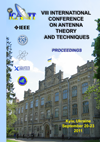Evolution of electromagnetic waves radiated by a Hertzian dipole
DOI:
https://doi.org/10.1109/ICATT.2011.6170714Keywords:
Hertzian radiator, Poynting vector, energy density, phase velocity, group velocity, velocity energy propagationAbstract
Evolution of electromagnetic waves, despite their use for more than century, is still not known. It was written much about poor understanding of the nature of electromagnetic waves. For example, Nobel Prize R. Feynman [1] writes: "... I must confess that we did not know what is actually allocated to the electromagnetic field energy." In a article [2] in 1905 A. Einstein wrote: "We intend to make an additional assumption, ... ... that the light in a vacuum always propagates with a certain velocity v, independent of the state motion of the radiation source." This "additional assumption" later turned into a principle tenet of which even today many scientists consider true.
I think that appearing of some new theories, which, as noted by M. Klein [3], " Work the mathematical rules and intelligent interpretation ... of the world, sadly, no" caused, in particular, the lack of clear, deep understanding of the nature and evolution of electromagnetic waves.
In literature, the definition of these concepts is given, based on the concept of "plane wave" — wave at a great distance from the radiator (in the far-field zone), where it is formed as a whole. At distances from the radiator to the far-field zone, these characteristics have been not studied.
The purpose of this study is to clarify the evolution of electromagnetic waves, clarification of the basic concepts of electrodynamics, for example, waves radiated by the Hertzian radiator.
References
FEYNMAN, R.; LEIGHTON, R.; SANDS, M. The Feynman Lectures on Physics. v.6, p.343.
EINSTEIN'S, A. Collected Works. V.1, Moscow: Nauka, 1965, p.7; v.2, Moscow: Nauka, 1966, p.3; v.3, Moscow: Nauka, 1966, p.7; v.4, Moscow: Nauka, 1966, p.7.
KLINE, M. Mathematics: The Search for Truth. Moscow: Mir, 1988 [in Russian].
BATYGIN, V.V.; TOPTYGIN, I.N. Collection of Problems in Electrodynamics. Moscow: Nauka, 1970 [in Russian].
LANDAU, L.D.; LIFSHITZ, E.M. Theoretical Physics. Textbook. Benefits: For the universities. In 10 vols VIII. Electrodynamics of Continuous Media, 4th ed. Moscow: Phithmathlit, 656 [in Russian].
KATZENELENBAUM, B.Z. High Frequency Electrodynamics. Moscow: Nauka, 1966, 240 p. [in Russian].
VAINSHTEYN, L.A.; SOLNTSEV, V.A. Lectures on Microwave Electronics. Moscow: Sov. Radio, 1973 [in Russian].
Linear Ion Accelerators. V.1, 2. Moscow: Atomizdat, 1978 [in Russian, ed. by B. P. Murin].
STRATTON, J.A. Electromagnetic Theory. Moscow: Gostechizdat, 1948 [in Russian].
Physical Encyclopedic Dictionary. V., 1960, 664 p.; v.2, 1962, 608 p.; v.3, 1963, 624 p.; v.4, 1965, 592 p. [in Russian, Ed. by B.A. Vvedensky, B.M. Vul].
VAINSHTEYN, L.A. Electromagnetic Waves. M.: Radio and Telecom., 1988, p.176-179 [in Russian].
NICHOL'SKIY, V.V. Electrodynamics and Propagation. Moscow: Nauka, 1978, p.56, 137 [in Russian].
MARCANO, D.; DIAZ, M. Energy transport velocity for Hertzian dipole. IEEE Int. Antennas Propagat. Symp. Dig., Jul. 2006, p.2017-2020, doi: http://dx.doi.org/10.1109/APS.2006.1710975.

